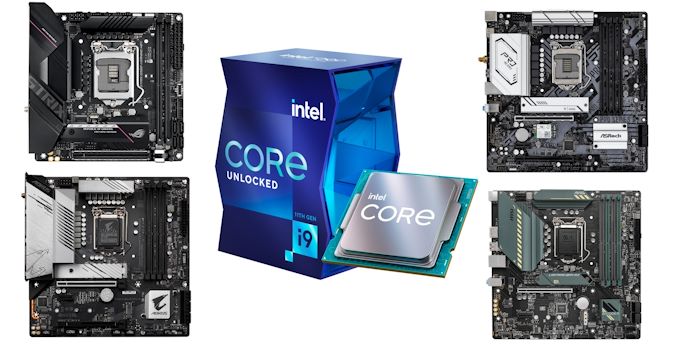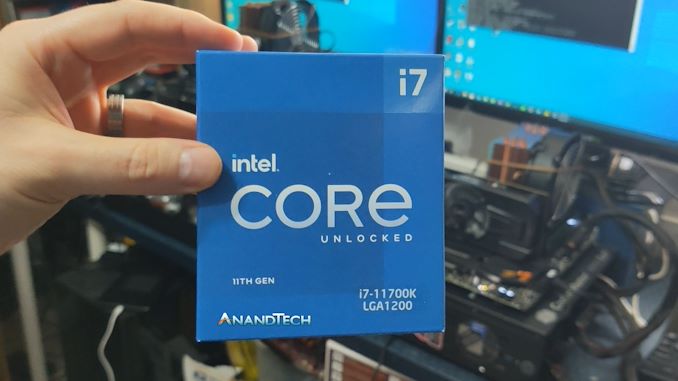Intel Rocket Lake (14nm) Review: Core i9-11900K, Core i7-11700K, and Core i5-11600K
by Dr. Ian Cutress on March 30, 2021 10:03 AM EST- Posted in
- CPUs
- Intel
- LGA1200
- 11th Gen
- Rocket Lake
- Z590
- B560
- Core i9-11900K
Conclusion
For anyone buying a new system today, the market is a little bleak. Anyone wanting a new GPU has to actively pay attention to stock levels, or drive to a local store for when a delivery arrives. The casual buyers then either look to pre-built systems (which are also flying off the shelves), or just hang on to what they have for another year.
But there is another way. I find that users fall in to two camps.
The first camp is the ‘upgrade everything at once’ attitude. These users sell their old systems and buy, mostly, all anew. Depending on budget and savings, this is probably a good/average system, and it means you get a good run of what’s available at that time. It’s a multi-year upgrade cycle where you might get something good for that generation, and hopefully everything is balanced.
The other camp is the ‘upgrade one piece at a time’. This means that if it’s time to upgrade a storage drive, or a memory kit, or a GPU, or a CPU, you get the best you can afford at that time. So you might end up with an older CPU but a top end GPU, good storage, good power supply, and then next time around, it’s all about CPU and motherboard upgrades. This attitude has the potential for more bottlenecks, but it means you often get the best of a generation, and each piece holds its resale value more.
In a time where we have limited GPUs available, I can very much see users going all out on the CPU/memory side of the equation, perhaps spending a bit extra on the CPU, while they wait for the graphics market to come back into play. After all, who really wants to pay $1300 for an RTX 3070 right now?
Performance and Analysis
In our Core i7-11700K review, our conclusions there are very much broadly applicable here. Intel’s Rocket Lake as a backported processor design has worked, but has critical issues with efficiency and peak power draw. Compared to the previous generation, clock-for-clock performance gains for math workloads are 16-22% or 6-18% for other workloads, however the loss of two cores really does restrict how much of a halo product it can be in light of what AMD is offering.
Rocket Lake makes good in offering PCIe 4.0, and enabling new features like Gear ratios for the memory controller, as well as pushing for more support for 2.5 gigabit Ethernet, however it becomes a tough sell. At the time we reviewed the Core i7-11700K, we didn’t know the pricing, and it was looking like AMD’s stock levels were pretty bad, subsequently making Intel the default choice. Since then, Intel's pricing hasn't turned out too bad for its performance compared to AMD (except for the Core i9), however AMD’s stock is a lot more bountiful.
For anyone looking at the financials for Intel, the new processor is 25% bigger than before, but not being sold for as big a margin as you might expect. In some discussions in the industry, it looks like retailers are getting roughly 20%/80% stock for Core i9 to Core i7, indicating that Intel is going to be very focused on that Core i7 market around $400-$450. In that space, AMD and Intel both have well-performing products, however AMD gets an overall small lead and is much more efficient.
However, with the GPU market being so terrible, users could jump an extra $100 and get 50% more AMD cores. When AMD is in stock, Intel’s Rocket Lake is more about the platform than the processor. If I said that that the Rocket Lake LGA1200 platform had no upgrade potential, for users buying in today, an obvious response might be that neither does AM4, and you’d be correct. However, for any user buying a Core i7-11700K on an LGA1200 today, compared to a Ryzen 7 5800X customer on AM4, the latter still has the opportunity to go to 16 cores if needed. Rocket Lake comes across with a lot of dead-ends in that regard, especially as the next generation is meant to be on a new socket, and with supposedly new memory.
Rocket Lake: Failed Experiment, or Good Attempt?
For Intel, Rocket Lake is a dual purpose design. On the one hand, it provides Intel with something to put into its desktop processor roadmap while the manufacturing side of the business is still getting sorted. On the other hand it gives Intel a good marker in the sand for what it means to backport a processor.
Rocket Lake, in the context of backporting, has been a ‘good attempt’ – good enough to at least launch into the market. It does offer performance gains in several key areas, and does bring AVX-512 to the consumer market, albeit at the expense of power. However in a lot of use cases that people are enabling today, which aren’t AVX-512 enabled, there’s more performance to be had with older processors, or the competition. Rocket Lake also gets you PCIe 4.0, however users might feel that is a small add-in when AMD has PCIe 4.0, lower power, and better general performance for the same price.
Intel’s future is going to be full of processor cores built for multiple process nodes. What makes Rocket Lake different is that when the core was designed for 10nm, it was solely designed for 10nm, and no thought was ever given to a 14nm version. The results in this review show that this sort of backporting doesn’t really work, not to the same level of die size, performance, and profit margin needed to move forward. It was a laudable experiment, but in the future, Intel will need to co-design with multiple process nodes in mind.












279 Comments
View All Comments
schujj07 - Tuesday, March 30, 2021 - link
It would have the exact same power draw under AVX512 as AVX2. The 142ishW draw is socket maximum. The only way to increase power draw to the CPU socket is to change sockets.maroon1 - Tuesday, March 30, 2021 - link
Only way to get same power draw with AVX-512 is to lower clock speed a lot which effects performanceschujj07 - Tuesday, March 30, 2021 - link
That doesn't change the fact that Ryzen is socket limited for power draw. While lowering clocks affects performance, AVX512 could still be faster at same power draw on Ryzen.whatthe123 - Wednesday, March 31, 2021 - link
Zen 3 isn't socket limited. All you have to do is enable PBO and you can manually set the package limit to whatever you want. I can set my 5900x power limit to whatever I want, though the boost gains aren't worth the extra heat.Qasar - Wednesday, March 31, 2021 - link
um yes it is, 142 watts is as much as it can use : " Notably, AMD's decision to stick with the AM4 socket still constrains its maximum power consumption to 142W, which means that it could not increase power consumption for the new flagship models. "from here : https://www.tomshardware.com/reviews/amd-ryzen-5-5...
TheinsanegamerN - Wednesday, March 31, 2021 - link
Hrm um yeah, no, you're wrong.Gamers nexus measured over 190 watts on a 2700x, which is socket AM4:
https://www.gamersnexus.net/hwreviews/3287-amd-r7-...
29a - Wednesday, March 31, 2021 - link
Thats overclocked, non overclocked wattage is 142W. Nice try.SaturnusDK - Wednesday, March 31, 2021 - link
AM4 and whatever intel calls the current iteration of the 1150/1151/1200 socket has the exact same technical power limit. Well, almost. It's 142W vs 144W. Usually written as 125W (+15%).You can safely draw double that wattage through the socket though on both platforms. The interesting thing is that the 11th gen apparently throws all sense and caution to the wind in an attempt to stay competitive that they're willing to accept an obscene RMA percentage on the sales.
whatthe123 - Wednesday, March 31, 2021 - link
Toms literally contradicts itself in that article by running 5900x with PBO at 172 watt. Socket is not the limit, the bios imposed PPT is the limit.Oxford Guy - Wednesday, March 31, 2021 - link
What cooler was used? It bet it was stronger than the Noctua used here for AMD.